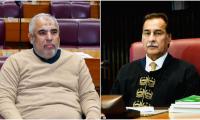KARACHI: Pakistan’s leather exports declined 21 percent to $18.45 million in July 2018 as prices declined globally due to cheap Chinese artificial leather supply, an industry official said on Tuesday.
In July 2018, the country’s tanned leather exports increased 26 percent in volume, while the value decreased by 21 percent to $18.45 million from $23.47 million in July 2017.
From July-June 2081, total exports of tanned leather remained down 7.7 percent to $349.43 million from $378.83 million from the same period in the corresponding year.
Gulzar Firoz, former president, Pakistan Tanners Association, told The News that demand of leather products had reduced by half because of artificial leather material produced by China.
“We are not alone. Brazil, US and Argentina, which are highest exporters of cow leather, are facing declining trend in prices,” he said.
Pakistan’s total leather garments’ exports increased in FY18 to $613.40 million from $486.74 million a year ago. The country has a meagre share between one and two percent in total global leather exports.
Pakistan has the finest quality footwear leather, and since share in total global footwear exports was negligible, the finished leather was exported to Italy, Portugal, Spain, South Korea, Cambodia and Vietnam, who manufacture world footwear brands, Firoz said.
“Leather production of Portugal, Spain and Italy has come down by 25 percent due to decline in the demand.”
Pakistan’s footwear leather exports rose to $87.31 million in FY18, as compared to $75.28 million during the same period last year. “Overall exports of leather products slightly increased in FY18 but due to a decline in the demand, prices remained too low,” he said.
Along with China’s infiltration of artificial leather, which is half the price of genuine leather, change in fashion was also a major reason behind a drop in leather prices in the international market.
“Now, youth prefer wearing joggers on jeans. It is the same in our country too,” he said.
“However, usage of handbags of genuine leather still remains in fashion.”
Pakistan’s golden period of leather exports was 2015-16, when total exports were recorded around $1.22 billion, which dropped by 10 percent annually for the next couple of years, said the businessman.
This season, hides of sacrificial animals also received lower rates in the market. Businessmen cite financial crunch, as they claim billions of rupees were stuck with the government under various refunds.
“This was the major reason behind 10 to 20 percent decline in animal hides this Eid-ul-Azha in the country, as buyers did not have sufficient money to purchase the raw material,” said Gulzar Firoz.
Since nobody could stop the fashion changing trends in the international as well as local market, he said, releasing payments of the exporters could help out the prices in the local market.
Chief Business Officer at Zindigi Atif Ishaque shaking hand with Ali Sufian, CEO of Green Agrimall. —...
The Shan Foods factory is seen in this image.— Shan Foods website/FileKARACHI: Shan Foods, a leading Pakistani food...
The logo of Engro Corporation is seen at its office in Karachi, Pakistan. — Reuters/FileKARACHI: Engro Corporation...
A representational image of gold jewellery. — AFP/FileKARACHI: Gold prices rose by Rs3,100 per tola on Wednesday in...
President of Federation of Pakistan Chamber of Commerce and Industry Atif Ikram Shaikh addressing a press conference...
A representational image of a person counting Chinese currency "Yuan" notes. — AFP/FileSINGAPORE/LONDON: High-level...







